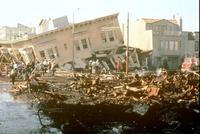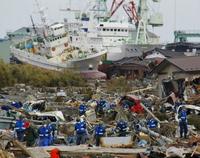-
Key to coping with disasters: neighbors
A political scientist who had moved to New Orleans only weeks before Hurricane Katrina concluded that neighbors — and cooperation among neighbors — are more important for surviving, coping with, and recovering from disasters than ambulances and fire trucks and government aid; to make sure his observations were more than anecdotal, he visited disaster areas around the world, and his data show that his personal experiences reflect a larger truth
-
-
Disasters hit businesses hard, keeping many permanently closed
Business owners across the United States are being urged to create emergency plans, so that they can continue operating in the wake of a natural disaster; according to the Insurance Institute for Business and Home Safety, 25 percent of businesses hit by a natural disaster are unable to continue functioning
-
-
Disasters a boon to junk removal business
Damaging weather — tornadoes, floods, hurricanes — can be a boon for the junk removal business; the past two years have seen a sharp uptick in the number of natural disasters hitting populated areas; just this spring we have witnessed the deadliest tornado season in almost sixty years; floods have wiped out homes and lives in Mississippi, Vermont, and Manitoba; Australia recovered from massive flooding in Brisbane only to be hit with an earthquake in nearby Christchurch, New Zealand; one junk removal company sees a significant uptick in revenues
-
-
Missouri Governor pledges $25 million for flood relief
On Tuesday, Missouri Governor Jay Nixon pledged $25 million in state aid to help cities and counties rebuild following crippling floods throughout the southern half of the state; it is unclear whether the state will be forced to make budget cuts in order to afford the disaster spending; on Monday President Obama issued a major disaster declaration for five Missouri counties; under the declaration residents of the five counties are eligible to apply for federal assistance for the costs of temporary housing, home repairs, and loans to cover uninsured losses
-
-
Australian floods and cyclone cost economy $6.6 billion
The devastating floods and cyclone that ravaged Australia last summer has cost the country’s economy more than $6.6 billion dollars; as the country begins to rebuild, the economy must deal with the loss of nearly $9 billion dollars, half a percentage point of real GDP, in production revenues, primarily from the coal and agriculture industry; the government plans to spend nearly $7 billion over the next six years to help communities rebuild, despite an expected loss in tax revenues of $1.75 billion
-
-
DHS IG criticizes FEMA's IT systems
DHS Inspector General says that FEMA’s IT systems “do not support disaster response activities effectively”; the IG recommends that FEMA develop a comprehensive IT strategic plan with clearly defines goals and objectives to support program IT initiatives, and that FEMA establish an agency-wide IT budget planning process to include all FEMA program technology initiatives and requirements
-
-
Missouri pounded by rains and tornadoes, thousands evacuate
This week heavy rain storms are raging across the mid-west and south forcing thousands of residents in Missouri to flee as swollen rivers threaten to flood their homes; in some areas emergency responders do not have many options and can do nothing but hope that the levees hold; the mid-west will not see any respite from the storms until Thursday as another major storm system is about to hit; officials are bracing for substantial flooding; the region is still struggling to recover from major storms that spawned tornadoes in six states killing forty-five people and damaging structures; Missouri has requested aid from the Federal Emergency Management Agency
-
-
Japanese app helps spread earthquake warning
After the 9.0 magnitude earthquake and tsunami ravaged Japan, hundreds of thousands of people have signed up for a new emergency warning app for their iPhones; when an earthquake is predicted to hit, the iPhone app, called Yure Kuru, will send out an alert and let subscribers know when the quake is coming, where the epicenter is located, and how bad the shaking will be; the app was developed by Tokyo based RC Solution Co., which specializes in mass alert systems and spreading information in the event of an emergency; since the 11 March earthquake, the company’s subscribers have sky rocketed from 100,000 to more than 1.5 million
-
-
Japan quake reconstruction could take ten years
Yesterday an advisory panel to the Japanese government announced that it could take a decade to rebuild Japan after the 11 March earthquake and tsunami wiped out much of north-eastern Japan; the council said that the first three years alone would be devoted to building roads and erecting temporary housing for the thousands of families that have been displaced; rebuilding towns could take another four years and a full recovery might take even longer; the damage from the recent quake was far greater than the large quake that struck Japan in 1995; Prime Minister Kan’s cabinet has approved almost $50 billion in spending for post-earthquake rebuilding
-
-
Twitter and natural disasters: lessons from Japan
Researchers from Kobe City University of Foreign Studies surveyed and questioned Twitter users and tracked updates from people in the disaster-struck area on the social media site two weeks after the Tohoku earthquake and devastating tsunami of 11 March; Twitter was the only functioning communication tool immediately after the earthquake; the researchers found that there benefits for using Twitter, such as bringing information to people involved in a disaster and to those hoping to hear news; there was a downside, though: Twitter helped spread unverified rumors and misinformation, causing people to panic in areas where there was no reason to panic, thus making the work of rescuers and service authorities more difficult; one solution: have the government itself use Twitter to offer reliable information to all involved
-
-
Disaster-zone phone communication software available for free
Australian researchers developed software which enables mobile phones to communicate during a disaster; it will be freely available to the public by the end of the year thanks to the support of the Dutch NLnet Foundation; the software can be used on compatible mobile phone handsets to create an alternative “network” where conventional mobile phone coverage has been destroyed or does not exist
-
-
Streamlined approach to U.S. preparedness
The administration has released a new presidential policy directive on national preparedness; the directive, the result of a comprehensive review of national preparedness policy, replaces Homeland Security Presidential Directive 8; the administration says that the directive seeks to move away from burdensome requirements and instead build the key capabilities the nation needs to confront any challenge
-
-
Waste management critical to natural disaster recovery
Disasters can typically generate up to fifteen years worth of a community’s solid waste over a few days, with the potential to overwhelm day-to-day solid waste operations and to lead to years of disruption; FEMA estimates that debris removal accounted for 27 percent of their total disaster response costs for those U.S. disasters between 2002 and 2007; prolonged problems with the management of solid waste can lead to public and environmental health issues; slow management of solid waste can also impede economic recovery by inhibiting rebuilding activities
-
-
Geologists push for earthquake early warning system despite costs

Geologists on the West Coast are actively pushing for an earthquake early warning system, similar to the one deployed in Japan; the Japanese warning system helped save lives as it gave people valuable extra time to prepare before the devastating 9.0 magnitude earthquake and tsunami hit; scientists want to place a similar network of data transmitters and information receivers along fault lines up and down the West Coast; geologists fear that a major impediment to the installation of the system would be its cost during times of fiscal austerity; the system would take roughly ten years to build and an estimated $145 million, making the project nearly impossible to undertake without federal funding
-
-
Japan begins road to recovery

Japan’s long road to recovery has already begun; it is estimated that more than 135,000 buildings were destroyed and the Japanese government estimates that the recovery will cost as much as $310 billion; in the Miyagi prefecture, 80 miles from the quake’s epicenter, construction will soon begin on 1,110 temporary homes to shelter the more than 243,000 people who are now homeless; authorities are struggling to provide those living in shelters with enough food, clothing, and sanitary supplies; experts believe that Japan can rebuild quickly; Miyagi plans on building 10,000 temporary homes
-
- All
- Regional
- Water
- Biometrics
- Borders/Immig
- Business
- Cybersecurity
- Detection
- Disasters
- Government
- Infrastructure
- International
- Public health
- Public Safety
- Communication interoperabillity
- Emergency services
- Emergency medical services
- Fire
- First response
- IEDs
- Law Enforcement
- Law Enforcement Technology
- Military technology
- Nonlethal weapons
- Nuclear weapons
- Personal protection equipment
- Police
- Notification /alert systems
- Situational awareness
- Weapons systems
- Sci-Tech
- Sector Reports
- Surveillance
- Transportation
Advertising & Marketing: advertise@newswirepubs.com
Editorial: editor@newswirepubs.com
General: info@newswirepubs.com
2010-2011 © News Wire Publications, LLC News Wire Publications, LLC
220 Old Country Road | Suite 200 | Mineola | New York | 11501
Permissions and Policies
Editorial: editor@newswirepubs.com
General: info@newswirepubs.com
2010-2011 © News Wire Publications, LLC News Wire Publications, LLC
220 Old Country Road | Suite 200 | Mineola | New York | 11501
Permissions and Policies
